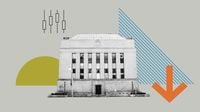Canada's job market is facing significant challenges, as the latest report from Statistics Canada reveals a rise in the unemployment rate to 6.9 percent in April 2025, up from 6.7 percent in March. Despite adding a modest 7,400 jobs during the month, experts warn that the overall economic picture remains grim, with many sectors struggling under the weight of U.S. tariffs and trade uncertainties.
The April Labour Force Survey indicates that while the economy managed to generate new positions, the net gain is considered negligible, especially when compared to the loss of 32,600 jobs in March. The report highlights a stark contrast in job growth between sectors, with significant losses in manufacturing and retail, which saw declines of 31,000 and 27,000 jobs respectively.
Leslie Preston, managing director and senior economist at TD Economics, noted, "Canada’s economy added jobs in April largely thanks to temporary work for the federal election, but scratch beneath the surface and Canada’s labour market continued to soften." This sentiment reflects a growing concern among economists that the temporary boost from election-related jobs is masking underlying weaknesses in the labor market.
Indeed, the goods-producing sectors have been hit particularly hard, losing a total of 33,000 jobs in April alone. Ontario, which is heavily integrated with the U.S. economy, has experienced the most severe impact, with 35,000 jobs lost in April and over 60,000 since February. The province's unemployment rate has now climbed to 7.8 percent, significantly above the national average.
Brendon Bernard, an economist at Indeed, stated, "The April Labour Force Survey showed the first direct hit from the trade war after several months of anticipation." He emphasized that the job losses are a stark reality of the ongoing trade tensions and tariffs imposed by the U.S. government.
In contrast, some provinces like Saskatchewan, Manitoba, and Prince Edward Island have reported improvements in their unemployment rates, indicating a more favorable labor market in those areas. However, the overall trend suggests a troubling outlook for job seekers across the nation.
Financial expert Shannon Terrell from NerdWallet echoed these concerns, stating, "April’s report indicates that the rumoured layoffs in response to the trade war have transitioned from worrisome headlines to harsh reality." She warned that Canadian households should prepare for a challenging economic environment as job availability continues to dwindle.
As businesses grapple with rising costs and reduced consumer confidence, many are implementing hiring freezes and cutting jobs to navigate the economic uncertainty. The impact of U.S. tariffs is evident, with economists like Tu Nguyen from RSM Canada noting that the manufacturing sector is particularly vulnerable to these external pressures. "April’s jobs report showcases the sheer impact of tariffs on the Canadian economy," Nguyen remarked.
Expectations for monetary policy adjustments are also shifting in light of these developments. Analysts predict that the Bank of Canada will likely cut interest rates in response to the weakening labor market. The current policy rate stands at 2.75 percent, and there is speculation that it may drop to 2.25 percent by the summer, as the central bank aims to stimulate economic growth.
Stephen Brown, deputy chief North America economist at Capital Economics, indicated that the labor market deterioration could signal the onset of a recession in Canada, particularly if tariffs remain in place. He stated, "The further weakening of the labor market increases the likelihood that the Bank of Canada will cut its policy rate at the June meeting."
In the wake of these challenges, the Canadian economy is navigating a complex landscape marked by both domestic and international pressures. The ongoing trade war, coupled with rising unemployment, has left many Canadians feeling uncertain about their financial futures.
The April report also highlights a troubling trend in wage growth, with hourly wages rising only 3.4 percent compared to the previous year, down from 3.6 percent in March. This slowdown in wage growth is concerning, particularly as Canadians face increasing costs of living.
Looking ahead, the outlook for Canada's labor market remains precarious. Analysts predict that if current trends continue, the unemployment rate could surpass 7 percent for the first time in over a decade, excluding the pandemic era. The potential for further job losses in manufacturing and trade sectors is particularly alarming, especially as the summer approaches.
The Canadian Chamber of Commerce's Andrew DiCapua remarked, "Canada’s labour market enters the fog of trade war on weaker ground." The uncertainty surrounding trade policies and their implications for job growth will be a critical factor to monitor in the coming months.
As the situation evolves, it is clear that the Canadian economy is at a crossroads. Policymakers will need to address the challenges posed by tariffs and trade uncertainties while fostering an environment conducive to sustainable job growth.
In conclusion, while Canada added some jobs in April, the overall labor market remains fragile, and the impacts of U.S. tariffs are becoming increasingly evident. Without significant policy changes or resolution of trade disputes, the outlook for Canadian workers and the economy as a whole could become even more challenging in the months ahead.






